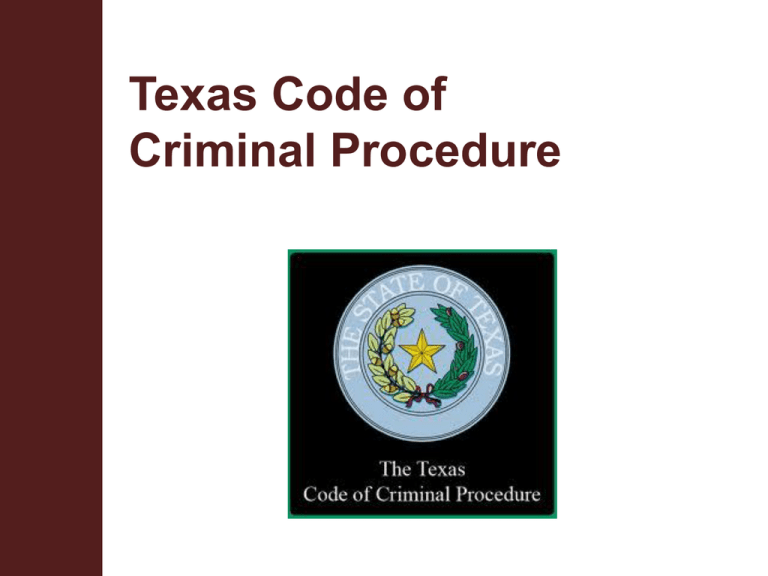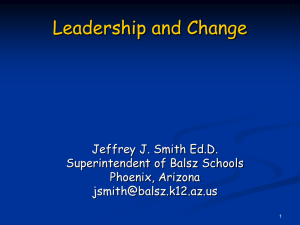
Texas Code of
Criminal Procedure
Terminal Objective
Upon completion of this module, the
participant will be knowledgeable about the
sections of the Code of Criminal Procedure
that would be most applicable in a school
environment.
Enabling Objectives
Identify the duties and powers of a peace officer.
Explain when and why notification of an arrest or
taking custody of a child must be made to a school.
Explain the procedures to follow when taking a child
into custody, including for a curfew violation.
Explain the circumstances requiring notice to the
superintendent or school administrator of juvenile sex
offenders enrolled in their district.
Explain the duties of an officer when a report of a
missing child is filed.
Explain the duties of the school when a report of a
missing child is filed.
Who Are Peace Officers?
CCP – 2.12
Sheriffs and their deputies
Constables and deputy constables
Marshals or police officers of an
incorporated city, town or village
Officers commissioned under Section
37.081, Education Code, or Subchapter E,
Chapter 51, Education Code
There are 36 different types of Peace
Officers in Texas
Duties and Powers of
Peace Officers CCP – 2.12
To preserve the peace within the officer’s
jurisdiction
To use all lawful means to effect this purpose
Interfere without warrant to prevent or
suppress crime
Execute all lawful process issued to the
officer by any magistrate or court
Give notice to some magistrate of all
offenses committed within the officer’s
jurisdiction
Arrest offenders without warrant in every
case where the officer is authorized by law
Take possession of a missing child
Duty of Peace Officers
as to Threats
CCP – 6.05 & 6.06
Peace officers have a duty to prevent any
threatened injury. The peace officer may use
the amount of force necessary to prevent the
commission of the offense – no greater.
Notification to Schools
CCP – 15.27
If you arrest or refer a child to the office designated by
the juvenile board and you believe is enrolled in a
public primary or secondary school, you must attempt
to ascertain whether that child is enrolled.
If they are enrolled, the head of the agency must orally
notify the superintendent of that arrest or referral within
24 hours, or before the next school day (whichever is
earlier).
If the child is a student, the superintendent or the
superintendent's designee shall immediately notify all
instructional and support personnel who have
responsibility for supervision of the student.
All personnel shall keep the information received
confidential.
Notification to Schools
Within 7 days after the oral notice is given, the
head of the agency shall mail written notification,
marked “PERSONAL AND CONFIDENTIAL” on
the envelope, to the superintendent.
The information contained in the notice shall be
considered by the superintendent in determining
whether there is a reasonable belief that the
student engaged in conduct defined as a felony
offense by the Penal Code.
Personal &
Confidential
Notification of School
As of 09/01/2011, any 17 or 18 year old student
that is placed in a county jail, that county’s staff is
required to notify the home school district within 24
hours by phone and within 7 day’s in writing. If the
incarceration may last several weeks, etc., the
home school district may with draw the student
and he/she SHALL be enrolled in the school
district where the county jail is located. The county
Sheriff’s office will assist the school district in
making sure the student receives his/her school
work while incarceration. (if the student is 17, the
judge can also order him/her into GED program if
these classes are available in the county jail.)
Who Else Must Notify?
CCP – 15.27
The Office of the Prosecuting Attorney,
upon conviction, deferred prosecution, or
deferred adjudication of a student
A parole or probation office if the student
transfers schools or returns to school
Electronic Notification
CCP – 15.27
A person may substitute electronic
notification for oral notification where oral
notification is required by this article.
If electronic notification is substituted for oral
notification, any written notification required
by this article is not required.
Children Taken Into Custody
What can you do with a child taken into
custody? If the offense is one that a justice or
municipal court would have jurisdiction of, you
can:
Release the child to a parent, guardian, or
responsible adult (see Section 52.02(a)(1),
Family Code)
Take the child only to a place previously
designated as an appropriate place of non-secure
custody for children (few exceptions)
Children Taken Into Custody
CCP – 45.058
The child may be held in a nonsecure facility only long
enough to accomplish the purpose of identification,
investigation, processing, release to parents, or the
arranging of transportation to the appropriate juvenile court,
juvenile detention facility, etc.
The child must be under continuous visual supervision by
facility staff during the period of nonsecure custody
The SIX HOUR RULE applies!
Children Taken into Custody for
Violation of Juvenile Curfew or Order
CCP – 45.058
A peace officer taking into custody a person
younger than 17 years of age for violation of
a juvenile curfew ordinance or order shall,
without unnecessary delay:
1. Release the person to the person’s parent,
guardian, or custodian;
2. Take the person before a justice or municipal
court to answer the charge;
3. Take the person to a juvenile curfew
processing office
Circumstances Requiring Notice to
Superintendent or Administrator
CCP – 62.054
Local law enforcement must provide notice to the
superintendent and school administrator only if:
1. The victim was at the time of the offense a child
younger than 17 or a student enrolled in secondary
school;
2. The person subject to registration is a student
enrolled in secondary school; or
3. The basis on which the person is subject to
registration is a conviction, deferred adjudication, or
an offense under the laws of another jurisdiction’s
law that contains substantially similar elements
Notification for
Registered Sex Offenders
CCP – 62.053
Upon receiving a registration form and verifying
the information, the local law enforcement
agency shall immediately provide notice to the
superintendent and administrator of any school
located in the district. The superintendent shall
relay the information to appropriate school
district personnel, including peace officers and
security personnel, principals, nurses and
counselors.
Missing Children
CCP – 63.009
Upon receiving a report of a missing child, local law
enforcement agencies must:
If the well-being of the child is in danger –
immediately start an investigation
If the well-being of the child is not in danger – start an
investigation with due diligence
Immediately (no later than 2 hours) enter the name of
the child into the missing child clearinghouse and the
national crime information center missing person file,
and inform the person making the report that this is
being done
School Records System
CCP – 63.09
On enrollment of a child under 11 years of age in a
school for the first time, the school shall:
Request the name of each previous school attended
Request from each school the child’s records
Notify the person enrolling that within 30 days, they
must provide:
Birth certificate or other proof of identity
If the school must inform law enforcement before
the 31st day after failure to comply, and law
enforcement will immediately check the
clearinghouse to see if the child is reported missing.
Flagging Records
CCP – 63.021
Once a school has received notification by
law enforcement that a child is missing, the
school shall maintain the child’s records in
its possession so that on receipt of a request
regarding the child, the school will be able to
notify law enforcement that a request for a
flagged record has been made.
References
Texas Code of Criminal Procedure










